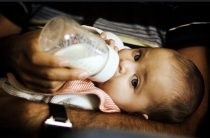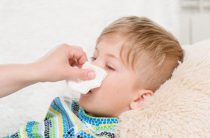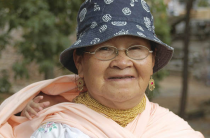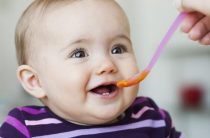In general, breastfeeding mothers do not need a total diet restriction. The main products excluded are citrus fruits, honey, seafood, marinades and smoked meats, spicy and fried foods. However, if the baby has an allergy, then the range of food restrictions is significantly narrowed so that allergens do not invade the child's body along with the milk that the mother feeds him.
This practice of dietary restrictions is called a “hypoallergenic diet.” A hypoallergenic diet intended for a nursing mother is used in a number of cases:
- The baby was diagnosed with allergies. Even if they are expressed by minor skin manifestations;
- During the first months of breastfeeding. Such severity, in this matter, is due to the fact that it is not known whether the baby has an allergic predisposition;
- If the child has deviations in the functioning of the digestive system. Especially when they disrupt the processes of splitting and assimilation of food. In this case, proteins that penetrate with milk may not be completely digested and recognized by the body as foreign bodies;
- If there are hereditary prerequisites for the development of allergies. This is due to the fact that a child in whose family there are allergies increases the risk of developing allergic diseases. In this case, it is impossible to predict the nature of the allergens, so, just in case, strict dietary restrictions are applied to the mother.
 It would seem that in this case it is much easier to transfer the child to feeding with artificial mixtures. But in practice, this is far from the best way. No matter how good formula is, it cannot replace full breast milk, which is the best choice for a baby's health. It is under the influence of mother's milk that a healthy body of the baby is formed. An important fact is that children receiving artificial mixtures are much more likely to acquire allergic diseases.
It would seem that in this case it is much easier to transfer the child to feeding with artificial mixtures. But in practice, this is far from the best way. No matter how good formula is, it cannot replace full breast milk, which is the best choice for a baby's health. It is under the influence of mother's milk that a healthy body of the baby is formed. An important fact is that children receiving artificial mixtures are much more likely to acquire allergic diseases.
In addition, the unpreparedness of the child's body for natural ingredients can somehow turn into bouts of allergic reactions, with the introduction of natural feeding, in the future. In addition, the ingress of components of the mother's food into breast milk has not only a harmful effect. Thus, the child already from the first months gets acquainted with natural food, and in minimal dosages.
Child and allergies
With allergies in a child, a nursing mother has to deal with very often.
The main allergens for an infant are food. Mothers often think that in the first 5-6 months the baby is completely protected from food allergens. Alas, this is far from the case. Allergenic components can penetrate into breast milk, which cannot be an allergen. Most allergens are proteins. It is to the penetration of proteins into the blood that the child's immunity begins to react sharply, subject to the presence of heightened sensitivity. In addition, some foods that are not allergens to the child themselves can exacerbate allergy symptoms.
This is due to the fact that the substances included in them can have an impact on the processes of histamine metabolism in the child's body. This hormone, released under the influence of an allergen, directly causes allergy symptoms. It can be difficult for a nursing mother to independently track the dependence of the development of allergy symptoms on the products entering the baby's body. Symptoms in this case may develop slowly. In some cases, from the moment the allergens are introduced, a week may pass before the development of symptoms of the disease. For this reason, it can be extremely difficult to navigate the causes of the development of food allergies and only specialists should deal with this.
Manifestations of allergies in children:
| Symptom Name | Its manifestations |
| Diathesis | The appearance of peeling on the skin, nodular rashes filled with liquid contents, overdrying of the skin, scales, redness accompanied by itching, swelling of the skin. |
| Gastrointestinal symptoms | Stool disorders, constipation, diarrhea, intestinal colic, nausea and vomiting. |
| Respiratory symptoms | Sneezing, allergic rhinitis with transparent contents, difficulty in breathing, presence of bronchial asthma. |
| Quincke's edema | Swelling of skin tissues, lips, larynx, space around the eyes. Critical acute form of an allergic reaction. Accompanied by a decrease in pressure, redness of the whole body. |
First steps for allergies in a child
And so, if you find symptoms in your baby that resemble an allergic reaction, then the first step is to contact a doctor who specializes in allergic reactions in children.
This specialist is a pediatric allergist. It is strictly forbidden to attempt self-diagnosis, treatment, as well as to organize a menu for the mother. This can be a negative factor for a nursing mother and her child. Only the conclusion of a qualified specialist, based on all the necessary data, can be a diagnosis. A rash in a child develops not only under the influence of food allergens, but also with improper care of the child or exposure to household chemicals or cat hair. In this case, strict dietary restrictions are absolutely not required.
Nursing mother's menu
And so, if the nature of the allergic reaction in the baby is not established or does not have food origin, then in this case, products that can enhance allergic manifestations are excluded, due to their biological properties. The purpose of the special menu is to avoid the ingestion of substances that increase allergy symptoms through mother's milk into the child's body.
Often there is a wrong approach on the part of the mother, in which the word diet is interpreted incorrectly. And so, a special menu for nursing is not a diet for weight loss. As such, an allergen-free diet is not a way to lose weight. On the contrary, the daily calorie content of the diet can be a quarter higher and, moreover, should increase as the baby grows, because his needs also increase. Naturally, the menu for a nursing mother, based on the exclusion of sweets, carbonated drinks, fatty and fried foods, indirectly affects, in terms of weight normalization, after pregnancy. But these measures are not used as a means for losing weight. It is necessary to organize measures to stabilize the weight at the end of the feeding period.
General diet for breastfeeding
And so, general recommendations for organizing the menu apply to all nursing mothers, regardless of whether the child suffers from allergies. Stimulation of lactation, during the feeding period, is an extremely energy-consuming process. In this regard, it is first necessary to increase the calorie content of the diet, which in some cases can be raised to 3500 kcal. This figure is 40% more than the usual recommended calorie intake (about 2000 kcal). The menu of a nursing mother should contain such important food components as: complete proteins, carbohydrates, healthy fatty acids, vitamins and minerals.
Increasing the calorie content should occur at the expense of high-quality and low-allergenic foods. These include: lean meats and poultry, cereals, dairy products, whole grain bread, vegetables and fruits.
Lean meat
And so, meat is primarily a high-quality source of protein. Meat protein contains all the amino acids required by the human body, while plant protein is far from being such a complete product. In addition, the absorption of protein obtained with meat is close to 100%. Lean meat contains virtually no cholesterol, an extremely harmful animal fat that contributes to the development of cardiovascular disorders.
Lean meats have the following benefits:
- complete amino acid composition;
- highly digestible protein;
- well-absorbed iron, which is necessary for vital processes
- oxygen transport;
- contributes to the normalization of hemoglobin;
- contains collagen, which contributes to the health and strength of the skin, joints and hair.
And so, what kinds of meat and poultry are considered lean: chicken, turkey, rabbit meat, veal, beef, lamb, as well as lean parts of pork (tenderloin).
cereals
Cereals are the seeds of special crops that are used by humans for food after special processing. A nursing mother should give preference to buckwheat, rice cereal, lentils, peas, pearl barley. The main useful property of cereals is the presence in the composition of a large amount of carbohydrates that are optimal for humans. As we know from the biology course, carbohydrates are the energy that the body needs, both for physical and mental activity, and for maintaining biological processes.
A lactating mother has a greater need for carbohydrates to produce milk. The lack of this element in the diet, during feeding is unacceptable! But carbohydrates are different for carbohydrates. Those carbohydrates that come to us from sugar, pastries, white flour products increase the concentration of sugar in the blood, resulting in heart and vascular diseases. Diabetes is also provoked by low-quality carbohydrates. While cereal carbohydrates are absorbed gradually, providing stable energy and do not harm health. In addition to high-quality carbohydrates, cereals contain dietary fiber, vitamins and minerals. Dietary fibers are indigestible carbohydrates that are necessary for the functioning of the intestines, which is responsible for the absorption of beneficial food components.
The benefits of cereals for nursing
| Groats | Beneficial features |
| Buckwheat | Contains potassium and magnesium, which make the cardiovascular system and kidneys productive. In addition, buckwheat among cereals is the most valuable in terms of protein content. |
| Rice | Rich in vitamin E, it also contributes to the normalization of salt balance, prevents anemia. |
| Millet | This cereal is the first when it comes to the content of vitamins. |
| oatmeal | Helps protect the gastrointestinal tract, normalizes peristalsis, reduces the level of bad cholesterol. |
| Barley | Enriched with B vitamins and various amino acids. |
Dairy products
Unlike milk, which is highly allergenic, fermented milk products on the menu of a nursing mother with an allergy in a child are not only not harmful, but, on the contrary, are very useful. Naturally, this statement does not apply to products in the preparation of which preservatives, dyes and sugars are used. Therefore, when choosing these products, carefully monitor the composition.
Another argument of natural fermented milk products against milk is its good digestibility. During the preparation of fermented milk products, lactose is digested, which many adults cannot digest, in the composition of milk. At the same time, there is no loss of calcium and high-quality protein during the cooking process. Vitamin D, which is also preserved, promotes the absorption of calcium by the bones and has a strengthening effect.
Only in the composition of fermented milk products are bacteria useful for the human body. These bacterial cultures, getting into the intestines, contribute to the normalization of the intestinal microflora. The health of the intestinal microflora is the key to the full assimilation of the beneficial components of food. Therefore, fermented milk products should take their place in the daily menu of a nursing mother.
Vegetables and fruits
Fruits and vegetables that are part of the menu of a nursing mother should be selected as fresh and unprocessed as possible. It is vegetables and fruits of the first freshness that are used as food along with the peel contain a large concentration of vitamins and minerals, vegetable fibers and healthy carbohydrates. Natural acids, which are found in fruit fruits, promote the absorption of animal proteins.
Diet recommendations for breastfeeding mothers:
- Fatty foods are excluded, as well as fried foods;
- Sausage products are subject to exclusion in any form;
- The use of spices should be minimized;
- Less onions and garlic;
- Refuse canned foods, marinades, instant foods;
- Cessation of alcohol and tobacco use;
- Food is prepared by stewing, steaming and baking;
- Onions and garlic are used to a minimum.
Products to be excluded from the menu:
- honey and other bee products;
- all kinds of nuts;
- highly allergenic fruits and vegetables;
- products from cocoa beans;
- corn and cornmeal dishes;
- duck meat, lamb and fatty parts of pork;
- seafood and fish caviar;
- celery;
- vegetables and fruits that are not specific to the place of residence of the nursing mother;
- coffee;
- hard cheeses (especially long-term cooking);
- beans and cabbage.
Menu of a nursing mother with allergies in a child
When choosing a menu for a nursing mother, it is necessary to observe the principles of diversity and a large number of high-value food nutrients. To do this, you need to use daily:
- 120 g of pure protein (the content of protein of animal origin is not less than 70-80 grams);
- 120g. fats from healthy foods;
- about 500g. carbohydrates from cereals and whole grain bread.
















In each case, the degree of restrictions and the set of products are individual. It depends on how severe the allergy is in the baby, and also whether the mother herself is allergic.
In each case, the degree of restrictions and the set of products are individual. It depends on how severe the allergy is in the baby, and also whether the mother herself is allergic.